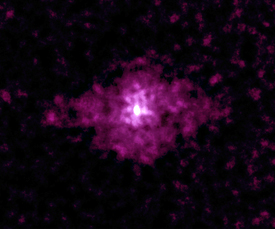September 6, 2001
CXC PR: 01-13
Astronomers examined the remnants of a stellar explosion with NASA's Chandra X-ray Observatory and discovered one of the youngest known pulsars. The properties of this pulsar, a neutron star rotating 15 times a second, will enable scientists to better understand how neutron stars are formed in the seconds just before a supernova explosion, and how they pump energy into the space around them for thousands of years after the explosion.
A team led by Stephen Murray of the Harvard-Smithsonian Center for Astrophysics in Cambridge, MA studied 3C58, the remains of a supernova observed on Earth in 1181 AD in the constellation Cassiopeia. In addition to a pulsating central source they observed an extended X-ray source surrounding the pulsar thought to be produced by a cloud of high-energy particles about 20 light years across.
These results were presented at the "Two Years of Science with Chandra" symposium in Washington, D.C. According to Murray, "Our discovery shows that all pulsars are not born equal. This pulsar is about the same age as the Crab Nebula pulsar, but there is little family resemblance."
Murray explained that the 3C58 pulsar, which is now rotating at about half the rate of the Crab pulsar, is rotating almost as fast as it was when it was formed. In contrast, the Crab pulsar was formed spinning much more rapidly and has slowed to about half its initial speed. Conventional theory has assumed that all pulsars were like the Crab, born with rapid rotation and then have spun down considerably. The observations of 3C58, along with Chandra observations by another group of scientists of a pulsar associated with the supernova of 386 AD have cast doubt on that assumption, however.
Furthermore, the X-ray power of 3C58 and its surrounding nebula are 20,000 and 1,000 times weaker than the Crab pulsar and its surrounding nebula respectively. One possibility for the low power of 3C58 is that the energy flow from its pulsar is primarily in the form of electromagnetic fields, so the energy is transported to much greater distances from the pulsar, where it has yet to be detected.
Another possibility is that the association of 3C58 with the supernova of 1181 AD is spurious, in which case 3C58 would be much older. In view of the lack of other radio and X-ray sources that could be the remnant of Supernova 1181 AD, this is considered unlikely.
The team also used X-ray data taken by NASA's Rossi X-ray Timing Explorer satellite in 1997 to confirm the existence of the pulsar and to measure its present slow-down rate. The Chandra observations were made on November 30, 1999, and December 23, 2000, using the High Resolution Camera (HRC), which was built by the Smithsonian Astrophysical Observatory in Cambridge, Mass. under the direction of Stephen Murray. NASA's Marshall Space Flight Center, Huntsville, AL, manages the Chandra program for the Office of Space Science, Washington, DC. TRW, Inc., Redondo Beach, California, is the prime contractor for the spacecraft. The Smithsonian's Chandra X-ray Center controls science and flight operations from Cambridge, MA.
Images associated with this release are available on the World Wide Web at:
MEDIA CONTACTS
Steve Roy
Marshall Space Flight Center, Huntsville, AL
Phone: 256-544-6535
Megan Watzke
Chandra X-ray Observatory Center, CfA, Cambridge, MA
Phone: 617-496-7998



